COSPAR ID 2011-040A Launch date 5 August 2011 Speed on orbit 0.17 km/s Cost 1.1 billion USD (2011) | SATCAT no. 37773 Max speed 265,000 km/h Orbit height 4,300 km Manufacturer Lockheed Martin | |
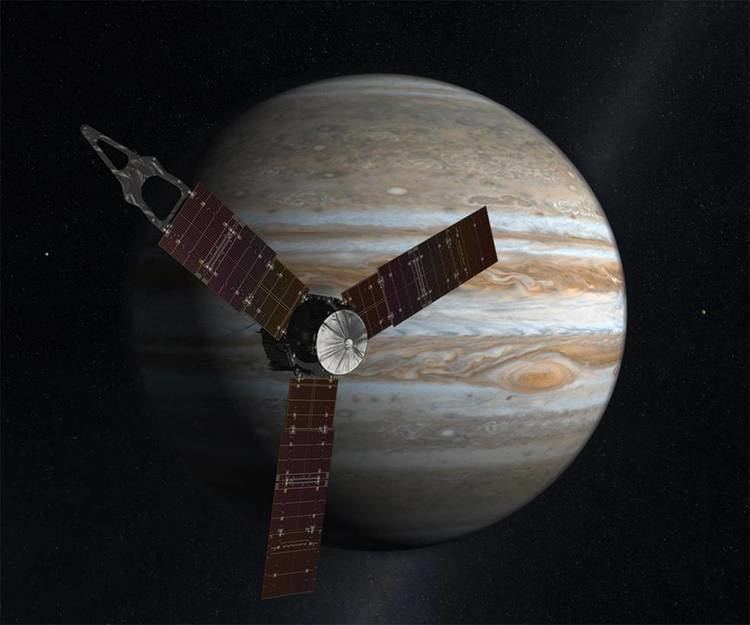 | ||
Mission duration Planned: 7 yearsElapsed: 5 years, 7 months, 10 daysCruise: 5 yearsScience phase: 2 years Similar Galileo, Dawn, Voyager 1, Curiosity, Rosetta | ||
Juno is a NASA space probe orbiting the planet Jupiter. It was built by Lockheed Martin and is operated by NASA's Jet Propulsion Laboratory. The spacecraft was launched from Cape Canaveral Air Force Station on August 5, 2011 (UTC), as part of the New Frontiers program, and entered a polar orbit of Jupiter on July 5, 2016 (UTC), to begin a scientific investigation of the planet. After completing its mission, Juno will be intentionally deorbited into Jupiter's atmosphere.
Contents
- Naming
- Overview
- Launch
- Earth flyby
- Insertion into Jupiters orbit
- Orbit and environment
- Planned deorbit and disintegration
- Team
- Cost
- Scientific objectives
- Scientific instruments
- Solar panels
- Telecommunications
- Propulsion
- Galileo plaque and minifigures
- References
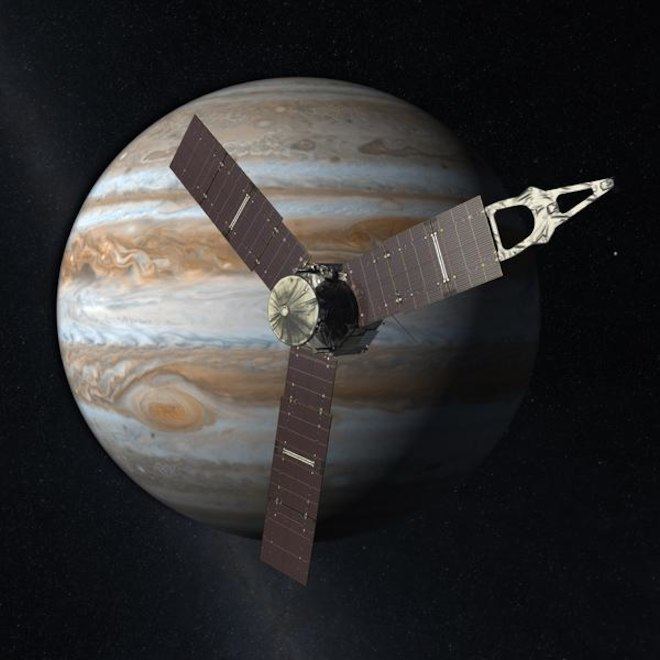
Juno's mission is to measure Jupiter's composition, gravity field, magnetic field, and polar magnetosphere. It will also search for clues about how the planet formed, including whether it has a rocky core, the amount of water present within the deep atmosphere, mass distribution, and its deep winds, which can reach speeds of 618 kilometers per hour (384 mph).
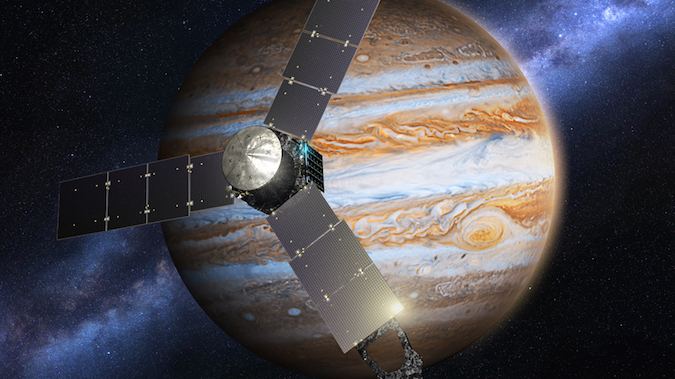
Juno is the second spacecraft to orbit Jupiter, after the nuclear powered Galileo orbiter, which orbited from 1995 to 2003. Unlike all earlier spacecraft to the outer planets, Juno is powered only by solar arrays, commonly used by satellites orbiting Earth and working in the inner Solar System, whereas radioisotope thermoelectric generators are commonly used for missions to the outer Solar System and beyond. For Juno, however, the three largest solar array wings ever deployed on a planetary probe play an integral role in stabilizing the spacecraft as well as generating power.

Naming
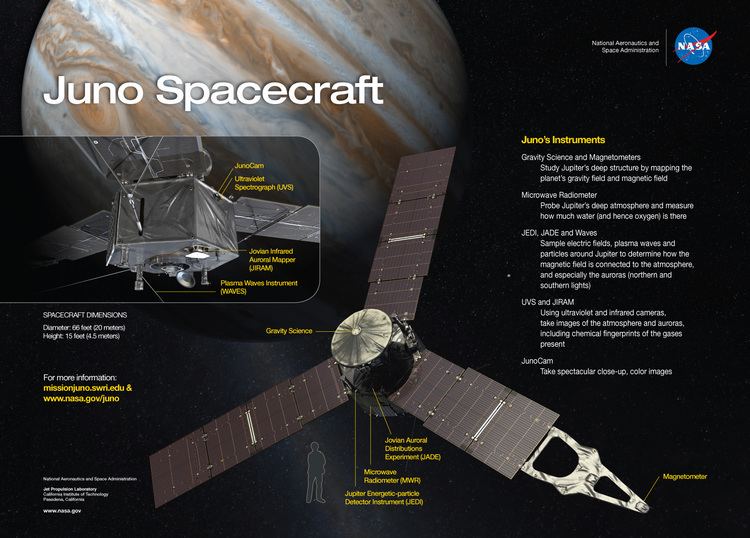
The mission had previously been referred to by the backronym Jupiter Near-polar Orbiter. Juno is sometimes called New Frontiers 2 as the second mission in the New Frontiers program, but is not to be confused with New Horizons 2 of the same program.
Overview
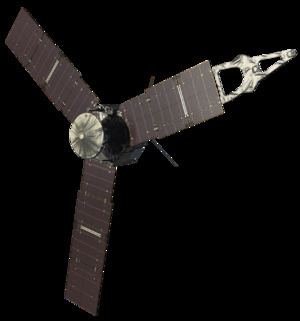
Juno was selected in 2005 as the next New Frontiers mission after New Horizons. The desire for Jupiter was strong in the years prior to this, but there had not been any approved missions. The Discovery Program had passed over the somewhat similar but more limited Interior Structure and Internal Dynamical Evolution of Jupiter (INSIDE Jupiter) proposal, and the turn-of-the-century era Europa Orbiter was cancelled in 2002. The flagship-level Europa Jupiter System Mission was in the works in the early 2000s, but funding issues resulted in it evolving into ESA's Jupiter Icy Moons Explorer.
Juno completed a five-year cruise to Jupiter, arriving on July 5, 2016. The spacecraft traveled a total distance of roughly 2.8 billion kilometers (18.7 astronomical units; 1.74 billion miles) to reach Jupiter. The spacecraft will orbit Jupiter 37 times over the course of 20 months. Juno's trajectory used a gravity assist speed boost from Earth, accomplished by an Earth flyby in October 2013, two years after its launch on August 5, 2011. The spacecraft performed an orbit insertion burn to slow it enough to allow capture. It will make three 53-day orbits before performing another burn on December 11 that will bring it into a 14-day polar orbit.
Once in the 14-day orbit, infrared and microwave instruments will begin to measure the thermal radiation emanating from deep within Jupiter's atmosphere. These observations will complement previous studies of its composition by assessing the abundance and distribution of water, and therefore oxygen. This data will provide insight into Jupiter's origins. Juno will also investigate the convection that drives natural circulation patterns in Jupiter's atmosphere. Other instruments aboard Juno will gather data about its gravitational field and polar magnetosphere. The Juno mission is set to conclude in February 2018, after completing 37 orbits of Jupiter, when the probe will be de-orbited to burn up in Jupiter's outer atmosphere, to avoid any possibility of impact and biological contamination of one of its moons.
Launch
Juno was launched atop the Atlas V at Cape Canaveral Air Force Station, Florida. The Atlas V (AV-029) used a Russian-designed and -built RD-180 main engine, powered by kerosene and liquid oxygen. At ignition it underwent checkout 3.8 seconds prior to the ignition of five strap-on solid rocket boosters (SRBs). Following SRB burnout, approximately 1 minute 33 seconds into the flight, two of the spent boosters fell away from the vehicle, followed 1.5 seconds later by the remaining three. When heating levels had dropped below predetermined limits, the payload fairing that protected Juno during launch and transit through the thickest part of the atmosphere separated, about 3 minutes 24 seconds into the flight. The Atlas V main engine cut off 4 minutes 26 seconds after liftoff. Sixteen seconds later, the Centaur second stage ignited and burned for approximately 6 minutes, putting the satellite into an initial parking orbit. The vehicle coasted for approximately 30 minutes, and then the Centaur was re-ignited for a second firing of 9 minutes, placing the spacecraft on an Earth escape trajectory in a heliocentric orbit.
Prior to separation, the Centaur stage used onboard reaction engines to spin Juno up to 1.4 RPM. About 54 minutes after launch, the spacecraft separated from the Centaur and began to extend its solar panels. Following the full deployment and locking of the solar panels, Juno's batteries began to recharge. Deployment of the solar panels reduced Juno's spin rate by two-thirds. The probe is spun to ensure stability during the voyage and so that all instruments on the probe are able to observe Jupiter.
The voyage to Jupiter has taken five years, which included an Earth flyby on October 10, 2013. On August 12, 2013, Juno had traveled half of its journey to Jupiter. As it reached the Jovian system, Juno had traveled approximately 19 AU.
Earth flyby
After traveling for two years in an elliptical heliocentric orbit, Juno returned to pass by Earth in October 2013. It used Earth's gravity to help slingshot itself toward the Jovian system in a maneuver called a gravity assist. The spacecraft received a boost in speed of more than 3.9 km/s (8,800 mph) and was set on a course to Jupiter. The flyby was also used as a rehearsal for the Juno science team to test some instruments and practice certain procedures before the arrival at Jupiter.
Insertion into Jupiter's orbit
Jupiter's gravity accelerated the approaching spacecraft to around 210,000 km/h (130,000 mph). On July 5, 2016, between 03:18 and 03:53 UTC Earth-received time, an insertion burn lasting 2,102 seconds decelerated Juno by 542 m/s (1,780 ft/s) and changed its trajectory from a hyperbolic flyby to an elliptical, polar orbit with a period of about 53.5 days. The spacecraft successfully entered Jupiter orbit on July 5 at 03:53 UTC.
Orbit and environment
Juno's highly elliptical initial polar orbit takes it within 4,200 kilometers (2,600 mi) of the planet and out to 8.1 million km (5.0 million mi), far beyond even Callisto's orbit. An eccentricity-reducing burn, called the Period Reduction Maneuver, is planned that will drop the probe into a much shorter 14 day science orbit. Juno is expected to complete 37 orbits over 20 months before the end of its mission.
These orbits minimize contact with Jupiter's dense radiation belts, which can damage spacecraft electronics and solar panels, by exploiting a gap in the radiation envelope near the planet, passing through a region of minimal radiation. The "Juno Radiation Vault", with 1-centimeter-thick titanium walls, will also aid in protecting Juno's electronics. Despite the intense radiation, JunoCam and the Jovian Infrared Auroral Mapper (JIRAM) are expected to endure at least eight orbits, while the Microwave Radiometer (MWR) should endure at least eleven orbits. Juno will receive much lower levels of radiation in its polar orbit than the Galileo orbiter received in its equatorial orbit. Galileo was damaged by radiation during its mission, including an LED diode in its data recording system.
The spacecraft completed its first flyby of Jupiter (perijove 1) on August 27, 2016, and captured the first-ever images of the planet's north pole.
On October 14, days prior to perijove 2 and the planned Period Reduction Maneuver, telemetry show that some of Juno's helium valves were not opening properly. On October 18, 13 hours before its second close approach to Jupiter, Juno entered into safe mode, an operational mode engaged when its onboard computer encounters unexpected conditions. The spacecraft powered down all non-critical systems and reoriented itself to face the Sun to gather the most power. Due to this, no science operations were conducted during perijove 2.
On December 11, the spacecraft completed perijove 3, with all but one instrument operating and returning data. One instrument, JIRAM, was off pending a flight software update. Perijove 4 occurred on February 2, with all instruments operating. The spacecraft will remain in a 53.4 day orbit for the remainder of the mission. The next perijove, number 5, will occur on March 27, 2017.
Although the mission's lifetime is limited by radiation exposure, almost all of this dose is acquired during perijove. The current 53.4 day orbit does not significantly increase radiation dose or decrease the planned number of perijove passes.
Planned deorbit and disintegration
Juno is scheduled to reach the end of the mission during its 37th orbit and perform a controlled deorbit and disintegrate into Jupiter's atmosphere. During the mission, the spacecraft will be exposed to high levels of radiation from Jupiter's magnetosphere, which may cause future failure of certain instruments and risk collision with Jupiter's moons. The controlled deorbit will eliminate space debris and risks of contamination in accordance with NASA's Planetary Protection Guidelines. The procedure will take 5.5 days, during which the spacecraft will end communications and descend into Jupiter's atmosphere. Because of the high velocity collision of the spacecraft and the dense atmosphere, Juno will burn up and disintegrate.
Team
Scott Bolton of the Southwest Research Institute in San Antonio, Texas is the principal investigator and is responsible for all aspects of the mission. The Jet Propulsion Laboratory in California manages the mission and the Lockheed Martin Corporation was responsible for the spacecraft development and construction. The mission is being carried out with the participation of several institutional partners. Co-investigators include Toby Owen of the University of Hawaii, Andrew Ingersoll of California Institute of Technology, Frances Bagenal of the University of Colorado at Boulder, and Candy Hansen of the Planetary Science Institute. Jack Connerney of the Goddard Space Flight Center served as instrument lead.
Cost
Juno was originally proposed at a cost of approximately US$700 million (fiscal year 2003) for a launch in June 2009. NASA budgetary restrictions resulted in postponement until August 2011, and a launch on board an Atlas V rocket in the 551 configuration. As of June 2011, the mission was projected to cost US$1.1 billion over its life.
Scientific objectives
The Juno spacecraft's suite of science instruments will:
Scientific instruments
The Juno mission's scientific objectives will be achieved with a payload of nine instruments on board the spacecraft:
Solar panels
Juno is the first mission to Jupiter to use solar panels instead of the radioisotope thermoelectric generators (RTG) used by Pioneer 10, Pioneer 11, the Voyager program, Ulysses, Cassini–Huygens, New Horizons, and the Galileo orbiter. It is also the farthest solar-powered trip in the history of space exploration. Once in orbit around Jupiter, Juno will receive 4% as much sunlight as it would on Earth, but the global shortage of Pu-238, as well as advances made in solar cell technology over the past several decades, makes it economically preferable to use solar panels of practical size to provide power at a distance of 5 AU from the Sun.
The Juno spacecraft uses three solar panels symmetrically arranged around the spacecraft. Shortly after it cleared Earth's atmosphere the panels were deployed. Two of the panels have four hinged segments each, and the third panel has three segments and a magnetometer. Each panel is 2.7 by 8.9 meters (8.9 by 29.2 ft) long, the biggest on any NASA deep-space probe.
The combined mass of the three panels is nearly 340 kg (750 lb). If the panels were optimized to operate at Earth, they would produce 12 to 14 kilowatts of power. Only about 486 W will be generated when Juno arrives at Jupiter, declining to near 420 W as radiation degrades the cells. The solar panels will remain in sunlight continuously from launch through the end of the mission, except for short periods during the operation of the main engine and eclipses by Jupiter. A central power distribution and drive unit monitors the power that is generated by the solar panels, distributes it to instruments, heaters and experiment sensors as well as batteries that are charged when excess power is available. Two 55-amp-hour lithium-ion batteries that are able to withstand the radiation environment of Jupiter will provide power when Juno passes through eclipse.
Telecommunications
Juno uses in-band signaling ("tones") for several critical operations as well as status reporting during cruise mode, but it is expected to be used infrequently. Communications are via the 34-metre (112 ft) and 70-metre (230 ft) antennae of the NASA Deep Space Network (DSN) utilizing an X band direct link. The command and data processing of the Juno spacecraft includes a flight computer capable of providing ~50 Mbit/s of instrument throughput. Gravity science subsystems use the X-band and Ka-band Doppler tracking and autoranging.
Due to telecommunications constraints, Juno will only be able to return about 40 megabytes of JunoCam data during each 11-day orbital period, limiting the number of images that are captured and transmitted during each orbit to somewhere between 10 and 100 depending on the compression level used. The overall amount of data downlinked on each orbit is significantly higher and used for the mission's scientific instruments; JunoCam is intended for public outreach and is thus secondary to the science data. This is comparable to the previous Galileo mission that orbited Jupiter, which captured thousands of images despite its slow data rate of 1000 bit/s (at maximum compression level) due to the failure of its high-gain antenna.
The communication system is also used as part of the Gravity Science experiment.
Propulsion
Juno uses a bipropellant LEROS 1b main engine, manufactured by Moog Inc in Westcott, Buckinghamshire in England. It uses hydrazine and nitrogen tetroxide for propulsion and provides a thrust of 645 newtons. The engine bell is enclosed in a debris shield fixed to the spacecraft body, and is used for major burns. For control of the vehicle's orientation (attitude control) and to perform trajectory correction maneuvers, Juno utilizes a monopropellant reaction control system (RCS) consisting of twelve small thrusters that are mounted on four engine modules.
Galileo plaque and minifigures
Juno carries a plaque to Jupiter, dedicated to Galileo Galilei. The plaque was provided by the Italian Space Agency and measures 7.1 by 5.1 centimeters (2.8 by 2.0 in). It is made of flight-grade aluminum and weighs 6 grams (0.21 oz). The plaque depicts a portrait of Galileo and a text in Galileo's own hand, penned in January 1610, while observing what would later be known to be the Galilean moons. The text translates as:
On the 11th it was in this formation - and the star closest to Jupiter was half the size than the other and very close to the other so that during the previous nights all of the three observed stars looked of the same dimension and among them equally afar; so that it is evident that around Jupiter there are three moving stars invisible till this time to everyone.
The spacecraft also carries three Lego minifigures representing Galileo, the Roman god Jupiter, and his sister and wife, the goddess Juno. In Roman mythology, Jupiter drew a veil of clouds around himself to hide his mischief. Juno was able to peer through the clouds and reveal Jupiter's true nature. The Juno minifigure holds a magnifying glass as a sign of searching for the truth, and Jupiter holds a lightning bolt. The third Lego crew member, Galileo Galilei, has his telescope with him on the journey. The figurines were produced in partnership between NASA and Lego as part of an outreach program to inspire children's interest in science, technology, engineering, and mathematics (STEM). Although most Lego toys are made of plastic, Lego specially made these minifigures of aluminum to endure the extreme conditions of space flight.
